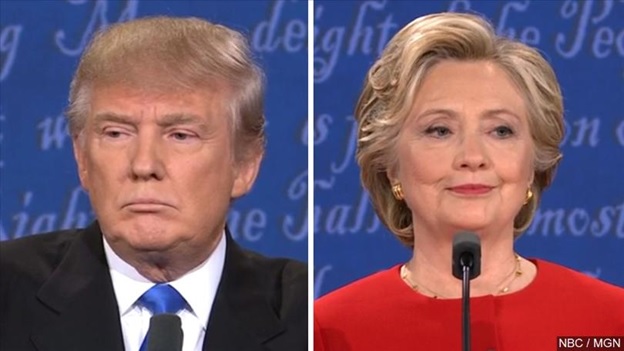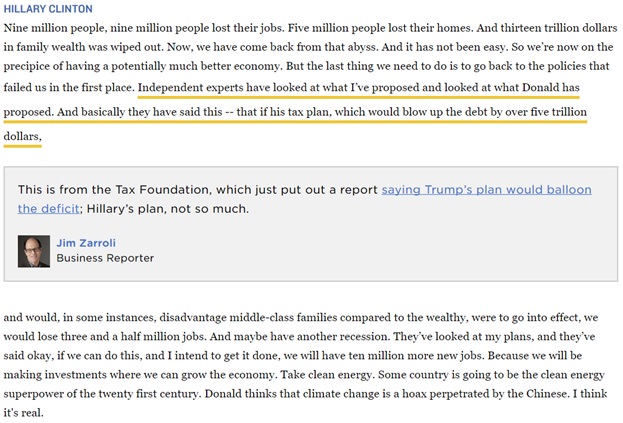This week, some of our posts will touch on our political climate, examining some of the lessons we can learn from the election about media, entertainment, radio, our culture, and ourselves. These posts are not meant to take sides, instigate a firestorm in our “comments” section, or agitate our readers. In the same way educators and historians will analyze and discuss this election for years to come, we see some important lessons in the political discourse, and hope you read these posts in the spirit in which they were intended. If you choose to comment – and we hope you do – please be sure to keep your observations “above the fray” or they will be deleted. – FJ

Now the totals are in, and Nielsen tells us that 84 million of us watched the Trump-Clinton debate last week. Overall, 13 TV networks aired live coverage of the debate, while millions of others viewers saw it online. All in all, a mega-audience for an event that does not involve a ball of any kind. You may remember that Donald Trump complained early on the debate the audience could very likely be stunted because it was up against a Monday Night Football game featuring the Falcons vs. the Saints. Apparently not.
But one of the big questions going into this historic debate revolved around the facts – notably, who was going to provide them whenever Trump or Clinton misspoke or out and out lied. Some feel the onus of truth-telling is on the moderator, but for the most part, Lester Holt was not obtrusive, letting the candidates generally go at each other.
Several news organizations tried their hand at fact-checking, and one of the most interesting treatments came from NPR. According to Poynter.org reporter Benjamin Mullin, NPR used a combination of its technology and intellectual capital to provide non-stop fact-checking throughout the debate. David Eads of the NPR Visuals team worked with a team to develop the technical end of the project. And then the journalists took over.
This blend of transcribing each candidate’s comments, loading it into Google Docs, and then turning to a group of 20 knowledgeable NPR reporters provided the information in a timely fashion. This mix of digital tools and savvy journalists turned out to be successful for NPR. In fact, they reported nearly 7½ million page views which set a record for web traffic on their website.
In automotive parlance, it’s called the HMI – or human machine interface, and it refers to precisely how a product or activity can be enhanced by a smart combination of tech and the personal touch.
Here are a couple of segments from the NPR debate transcript that shows how their debate project looked online:


The NPR debate experience reminded me of a GeekWire story by Kurt Schlosser this past spring about KEXP/Seattle’s efforts to digitize their entire library. Once again, we’re looking at a mashup of tech and talent that leads to the creation of something special. To give you an idea of the magnitude of this undertaking, KEXP estimates they have 41,000 CDs and 12,000 albums in their collection.
But the magic is the human factor: DJ notes on the albums, singles, and EPs that provide richer context about the music and the people who first played it. This is the intersection of audio, physical notes, personal anecdotes, and technology – something that simply couldn’t have been done before with traditional filing and catalogue systems.

In this way, this digital archiving creates an easy way for KEXP’s air talent to access their vast library, along with the notes and other content that can provide a richer on-air experience. KEXP’s DJs can better and more effectively connect with the audience, especially during breaking news events, whether it’s current news headlines or the recent passings of musical icons like Prince or Glenn Frey.
KEXP afternoon DJ, Kevin Cole, put it this way to GeekWire:
“The evolution of what’s sufficient and what people are expecting when it comes to interacting with music is constantly changing.”
Whether it’s fact-checking the most important debates in modern campaign history or curating one of the largest music collections in radio, the intersection of technology and human expertise is a pathway to moving radio into a compelling future.
The ability to combine data and digitization with the people factor is how a legacy medium like radio can create new experiences around old school events like a political campaign or a 4-hour DJ show. Harnessing the technology to connect our talent with our audience in ways we never could before is how we can modernize the traditional platform of radio.
Technology + talent = great radio experiences
So what’s next?
NPR will be fact-checking tonight’s Vice Presidential debate between Mike Pence and Tim Kaine. You can check out the action here.
Thanks to GeekWire’s Adam Rubens.
- The Hazards Of Duke - April 11, 2025
- Simply Unpredictable - April 10, 2025
- Flush ‘Em Or Fix ‘Em?What Should Radio Do About Its Aging Brands? - April 9, 2025




“Technology + talent = great radio experiences”–Well said and, as usual, spot-on.
With all deference to “The Six Million Dollar Man” (https://youtu.be/UV17B8oq_cE?t=47s), we have the technology.
Until radio gets the importance of the HMI, much of the industry will continue to live in the 1990s when it comes to using the incredible tools available to make interacting with radio, on ANY platform, an optimal experience. The best technology is useless if you don’t have the right people creating experiences with it.
The automakers know that. Amazon knows that. For the most part, radio doesn’t have a clue about that.
Thanks, Mark. And my hope is that by shining the spotlight on a couple of very recent examples of combining tech with human resources, we can stimulate more of these conversations. Rethinking how we do our jobs – and how we can do them better – is what ought to be driving us. We do indeed have the technology.
Fred,
As I mentioned on your blog a while ago – The Audio Engineering Society just wrapped in LA. Again, technology and the human touch. I dropped in at KROQ, and ended up doing a break promoting an event featuring the music of Beck. The latest innovations, and the men and women who make them happen –
that’s why Stevie Wonder showed up at AES, because he wanted to hear the new line from Genelec loudspeakers. This is especially key now that the NAB and AES will be combining forces at the Javits Center in NYC next year. This will be a wonderful hybrid, and a strange world for me, after spending 25 years in radio, then transitioning to audio. The evolution of communication has led us all down a similar corridor, and all the gear in the world still requires human beings as their most valuable component. Here’s to great microphones, the best music, and top-rank people to make them all magic!
Tai, thanks for the background and the comment. You’ll be especially interested in our newest initiative, detailed in today’s blog post: our Jacobs CES CEO Tour designed for radio broadcast executives. We’re hoping to move the needle. Thanks again.